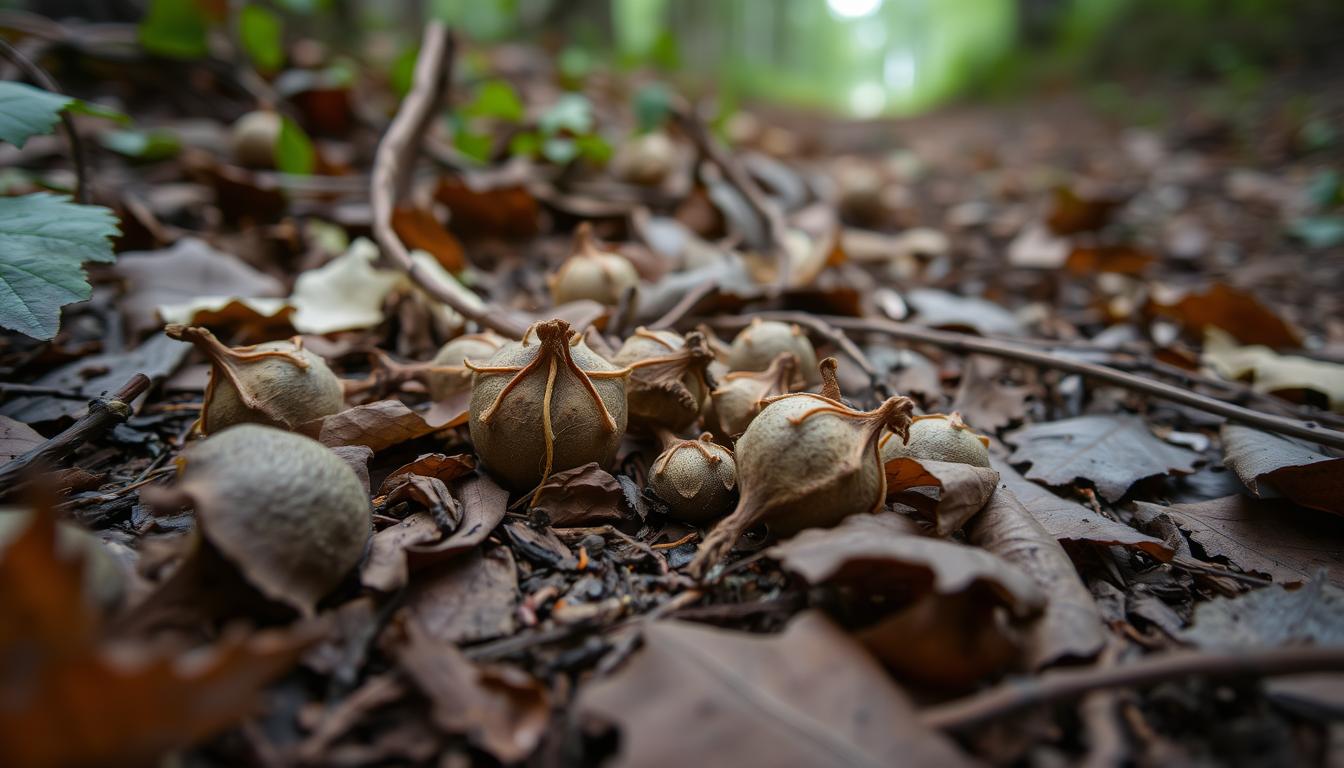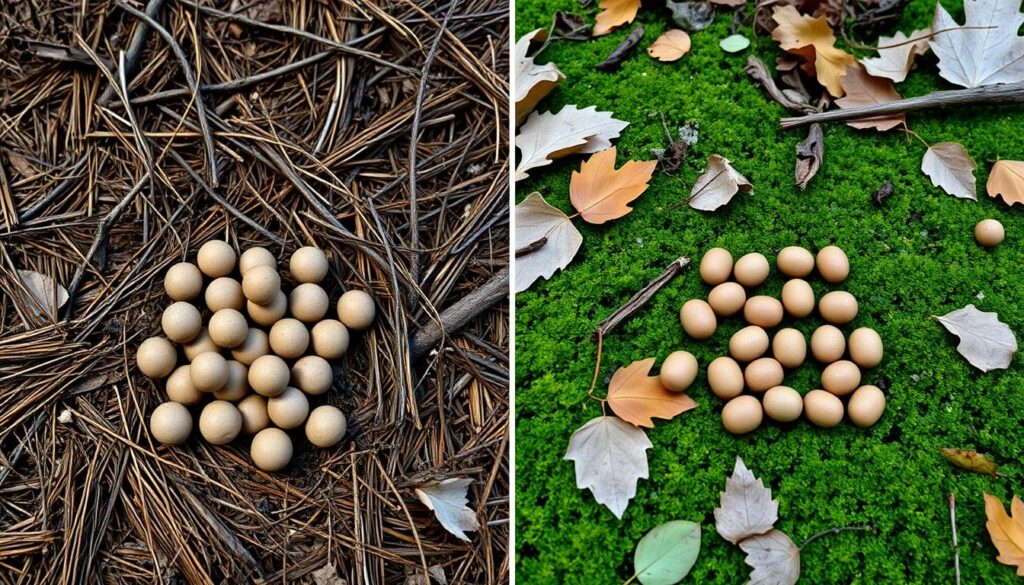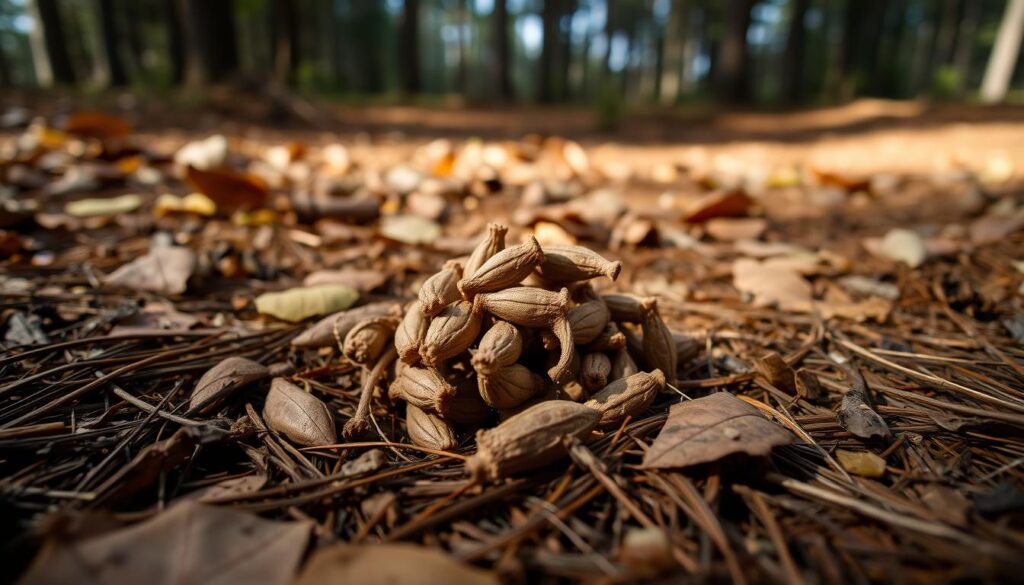Deer Poop: What It Tells You About Wildlife

An adult deer’s day is filled with grazing and alertness. In spring and summer, they defecate up to 30 times a day1. Deer excrement offers a unique look into their lives. It’s like a biological newsletter, showing us the details of wildlife scat and the ecosystem.
Both buck and doe scat looks similar, making it hard to tell their sex by waste alone2. Yet, deer poop holds a wealth of information. It shows how does hide their scent from predators and where deer are most active2.
Understanding deer droppings can reveal a lot about their lives. It’s important to handle deer excrement carefully, as it may contain Chronic Wasting Disease (CWD)2. By paying attention to deer poop, you might discover a fascinating story.
Understanding Deer Poop and Its Role in Nature
Deer scat holds important signs that we can learn from. By observing and analyzing, we can gain insights into deer and their habitats.
Key Takeaways
- Bucks and does produce similarly shaped scat, challenging sex-based differentiation.
- Deer excrement frequency varies throughout the year, with higher rates in spring and summer.
- The content and consistency of wildlife scat can indicate a deer’s recent diet.
- Fawn behavior and maternal interactions offer insights into their survival strategies.
- Deer scat serves as more than just waste; it’s a ledger of ecological health and behaviors.
- Health precautions are required during deer droppings examination due to disease risks.
Whether you’re a hunter or a nature enthusiast, learning about deer feces is valuable. It helps you understand the outdoors betterabout deer feces.
For those who care for pets, understanding pet food is key. It helps keep your furry friend healthy. Learn more about pet nutritionon pet food knowledge. A balanced diet is essential for a happy pet.
Understanding Deer Poop and Its Role in Nature
Deer droppings in the wild are more than animal waste. They show us the health and behavior of deer and their effect on nature. Let’s explore deer scat, its patterns, and why it’s important for the ecosystem.
The Basics of Deer Scat
Deer scat looks like small, dark brown pellets, often in clumps. Bucks have bigger clumps with 70 to 80 pellets, while does have 50 to 603. This scat is not just waste; it tells us about deer’s diet and health, mainly undigested plant material4.
Poop Patterns and Deer Behavior
Where and when you find deer feces can tell you about their movements and habits. Moist pellets mean deer were there recently, while dry pellets mean they’ve left3. Seeing a lot of deer poop in one place means it’s a feeding spot. In secluded areas, it’s where they rest3.
Deer Scat and Ecosystem Health
Deer scat is key in the nutrient cycle, helping soil and plants grow4. Scientists study deer poop to check for diseases like CWD, but its role in spreading CWD is still being studied3.
| Attribute | Description |
|---|---|
| Color and Texture | Dark brown to black, pellet shapes that vary depending on diet and health4. |
| Size Comparison | Deer droppings are significantly larger than rabbit droppings and less uniform in size4. |
| Seasonal Changes | Volume increases in spring and summer; reduced during fall and winter3. |
| Ecosystem Impact | Enhances soil fertility, supports plant growth, and indicates healthy deer presence4. |
Learning about deer scat helps us understand deer habits and their connection to nature. It shows how wildlife and their environments are linked. Deer poop gives us valuable insights into our natural world.
Decoding the Myths Around Deer Droppings
When you go outside, seeing deer droppings can teach you a lot about wildlife. It’s a myth that deer droppings show a deer’s sex. Knowing about deer droppings helps us understand wildlife and ecosystem health better.
Many hunters think buck and doe droppings are different. They believe buck poop is bigger and more tubular. But, research shows that buck and doe droppings are almost the same in size and shape5.
Looking at wildlife scat can tell us a lot. Fresh droppings mean there are many deer around. No droppings might mean deer numbers are going down5. Also, deer droppings can show what they eat and where they go to find food5.
Another myth is that deer droppings show what they eat or if they’re sick. While droppings can show what deer eat through tiny analysis5. Abnormal droppings can also hint at health problems, helping keep deer populations healthy5.
| Fact | Myth |
|---|---|
| Sex of deer cannot be determined by droppings’ size or shape5. | Buck droppings are larger and more tubular than doe’s. |
| Deer diet can be assessed via microscopic droppings analysis5. | Droppings’ shape indicates specific health conditions. |
| Fresh droppings indicate an active deer population5. | No droppings mean no deer in the area. |
Next time you’re outside, remember these facts. Understanding deer droppings makes your experience better. It also helps with conservation efforts. Keep exploring and stay informed!
What Deer Poop Can Indicate About Deer Habits
Deer droppings are more than just signs of deer presence. They offer insights into deer diet and habits. These clues help us understand animal behavior, like their feeding patterns and movements. This knowledge is key for tracking and managing wildlife.
Feeding Patterns Revealed Through Scat
By analyzing deer feces, we can see what they’ve been eating. This tells us their food sources at different times of the year. For example, green plant material in droppings means they’ve been grazing recently, common in spring and summer6.
In warmer months, their droppings are darker and moist. This changes to lighter, drier droppings in colder months as they eat more woody plants7. This info is vital for tracking their feeding habits and helping conservation efforts.
Bedding Areas and Poop Density
The amount and where deer droppings are found can show their favorite spots. Places with lots of scat are often where deer rest or forage7. These areas are safe from predators and harsh weather, making them key for spotting deer.
Distinguishing between doe and buck droppings can be tricky, as they look similar. But, bucks usually have more pellets per dropping, helping hunters identify gender from scat alone7. Fresh droppings mean deer have recently been there, useful for planning wildlife observations or hunts76.
By watching areas with lots of deer droppings, especially near water and food, we can predict deer movements. This helps in managing wildlife sustainably and improves hunting by finding where deer are most active7.
So, deer droppings are not just waste; they’re a wealth of information. They help us understand and manage deer populations effectively.
Distinguishing Between Buck and Doe Poop

Exploring nature trails or hunting can be exciting. Identifying deer droppings offers insights into local wildlife. You might wonder about the differences in buck versus doe poop. Both have similar shapes, but knowing the differences can deepen your outdoor knowledge.
Bucks produce 70 to 80 droppings per session, while does have about 50 to 60 pellets8. This difference is due to biological variations between genders. However, counting these pellets in the wild is hard.
It’s tricky to tell buck and doe poop apart just by looking. A Georgia study found slight size differences, but these are not always reliable for identification9.
To learn more about deer droppings and what they reveal, check out Deer Droppings Data8. This resource shows how analyzing deer scat can improve wildlife management and hunting.
If you want to stay clean while exploring or keep pets fresh after outdoor activities, visit The Ultimate Guide to Ensuring Your Pet Always Smells Fresh and9. Here, you’ll find tips on pet hygiene that are great for outdoor and wildlife lovers.
In conclusion, counting pellets in deer droppings can hint at whether it’s from a buck or doe. It’s a tough task but can greatly enhance your understanding of deer behavior and their habitat.
Deer Poop: Tracking the Wildlife Around You
Exploring wildlife through deer poop might not seem exciting at first. But it’s a deep dive into understanding wildlife. If you’ve walked through the forest and seen deer droppings, you’ve caught a glimpse of their lives. Amateur naturalists and enthusiasts use this to help local wildlife studies and conservation.
Citizen Science and Deer Poop Collection
Joining citizen science projects is rewarding. It lets you connect with nature and collect important data. By collecting deer feces, you help track deer, their health, and what they eat. Scat analysis shows deer habitats and migration patterns, helping prevent conflicts with humans.
Identifying Wildlife Through Scat
Wildlife scat tells a story. Did you know deer droppings vary by species? For example, red deer droppings are like olives, while roe deer droppings are smaller10. These differences help identify species and understand an area’s biodiversity.
Seeing animal scat means wildlife is nearby11. Deer droppings are common, but telling them apart from sheep scat needs a sharp eye10. This skill makes tracking and identifying wildlife more rewarding, enhancing outdoor adventures.
| Scat Type | Size Comparison | Typical Location |
|---|---|---|
| Red Deer | Size of an olive | Northern forests |
| Roe Deer | Smaller than olive | Eastern forests near villages |
| Common Sheep | Similar in structure to deer but different habitat | Grassy fields |
So, the next time you see wildlife scat, remember it’s more than waste. It’s key to understanding and protecting our wildlife ecosystems.
The Impact of Weather and Season on Deer Scat
Knowing how seasonal changes affect deer poop is key for wildlife fans and scientists. As seasons change, deer’s behavior and health also shift. This leads to changes in wildlife scat.
In fall and winter, deer move less and save energy for mating. This means they poop less often. But in spring and summer, they’re very active. They eat a lot to regain energy after mating. So, you’ll see more and bigger deer scat in warmer months.
Weather also changes deer scat’s look and how long it lasts. Rain, snow, and extreme weather can make scat look newer or older. This is important for hunters and wildlife watchers, as it can mess up tracking.
To learn more about how diet and behavior change deer scat, check out studies on white-tailed deer. They explore their biology and how they interact with their habitat12.
Seasonal changes affect deer droppings’ consistency and how often they appear. They also hint at deer population health and local ecosystem balance. So, next time you’re outdoors, watch for these small but important signs from wildlife.
Reading Signs: What Freshness and Texture Say About Poop
The state and look of deer droppings can tell you a lot. When checking scat freshness and timing of activity, fresh deer poop gives clues about recent wildlife in your area.
Fresh, wet, and dark deer droppings mean deer were there less than 12 hours ago. This is key for hunters or wildlife watchers trying to track them13. Dry, light-colored pellets are older, showing deer visited longer ago.
Timing of Deer Activity Based on Scat Freshness
Knowing how scat freshness links to deer activity times helps in tracking. For example, very fresh droppings early morning might mean deer are active at night.
Analyzing Texture for Dietary Insights
The texture of deer scat shows what they eat and where they find food14. Firm, pelleted scat means they eat woody plants, grains, and nuts, like a deer’s natural diet14. Soft, clustered scat means they eat more moist plants, like grasses and fruits, showing where they feed14.
| Scat Type | Texture | Dietary Insight |
|---|---|---|
| Deer | Firm, Pelleted | Woody plants, grains, nuts |
| Elk | Oval, Larger Pellets | Twigs, leaves, aspen bark |
| Pronghorn | Small, Oval, Towered | Scraping marks in male territory |
| Bear | Large, Less Formed | Berries, seeds, furry animals’ hair |
When exploring or hunting, remember these tips. They help you understand signs and scat analysis to guess deer and other wildlife’s habitats and food spots14.
Health Indicators: Assessing Deer Populations Through Poop

Deer droppings give us a clear view of deer health and population management. They act as key signs of wildlife diseases and environmental balance. This part explains how deer scat helps monitor deer numbers and spot diseases like chronic wasting disease (CWD).
Diseases Traced Through Scat
Looking at animal scat gives us important clues about wildlife diseases. Deer scat is especially useful for tracking CWD, a brain disease that affects deer and can spread through their poop. By studying scat, we can control disease spread and learn about its ecological effects. This method is also good for watching over ecosystem health and stopping epidemics15.
Poop Counts and Population Estimation
The amount and where deer scat is found tell us about population density and habitat. The Pellet Group Counts method uses poop counts to guess deer numbers in certain areas. These areas are usually about 1 square mile or 640 acres big. This method also shows how deer interact with their habitat, like how they eat plants, which affects plant health16.
| Indicator | Significance | Data Source |
|---|---|---|
| CWD Presence | Tracks neurodegenerative disease spread through deer scat | Wildlife Disease Surveillance |
| Poop Counts | Estimates deer population density | Pellet Group Counts Survey |
| Browsing Impact | Assesses habitat sustainability | Survey and environmental analysis16 |
Using data from these methods helps wildlife management work better. It balances deer control with ecosystem health, supporting biodiversity and natural environments. By analyzing and managing responsibly, you help keep wildlife populations healthy and thriving.
Safety Guidelines When Handling Deer Waste
When dealing with deer waste, it’s key to follow safety guidelines for disease prevention and health. Handling deer scat can be risky if not done right.
Wearing gloves and using the right tools can lower disease risk. Deer feces can carry diseases, so it’s vital to protect yourself.
Precautions to Prevent Disease Transmissions
While rare, disease transmission from deer feces disposal can happen. It’s wise to wear gloves and use tools for handling deer scat to avoid direct contact.
With more tick-borne diseases like anaplasmosis and ehrlichiosis, wearing protective clothes and tick repellents is crucial. This helps fight off disease carriers17.
Proper Disposal and Handling Methods
It’s important to dispose of deer waste properly for hygiene and to prevent environmental harm. Burying deer feces deeply or using designated services is recommended. This stops disease spread in wildlife.
Cleaning and disinfecting tools used for deer waste handling is essential for safety and disease prevention. Regular cleaning with the right solutions stops bacterial growth. This is especially important in areas with raw meats and animal waste18.
To find out more about disposing of deer carcasses and preventing chronic wasting disease, check out this guide17.
Conclusion
Deer poop is more than just waste. It’s a key to understanding wildlife behavior and health. Deer poop, with its thirteen daily droppings of about ninety-three pellets each, shows their constant interaction with their surroundings19.
By studying these small droppings, we learn a lot. We can tell deer apart from other animals like rabbits and raccoons. We also get clues about deer populations19. This knowledge helps us see how complex their lives are and how they affect their environment.
If you love nature and want to help your pets, there are steps you can take. You can find a vet that’s affordable without losing quality. This can help keep your pets healthy.
Learning about deer poop helps us appreciate nature more. It shows us how important deer scat is for understanding ecosystems and conservation. It’s not just about what deer eat. It’s about the connection between all living things and the environment19.
FAQ
What can deer poop tell us about wildlife behaviors and ecosystems?
How often do deer defecate and does it vary between seasons?
Can the shape of deer poop indicate whether it’s from a buck or a doe?
How does deer scat vary with diet?
What does the density and location of deer droppings indicate?
How can citizen science initiatives use deer poop?
Can you use deer scat to identify other wildlife?
Does the condition of deer poop change with weather?
How can the freshness of deer scat indicate recent deer activity?
What health indicators can be assessed through deer poop?
What precautions should you take when handling deer poop?
Why is the proper handling and disposal of deer scat important?
Source Links
- https://www.outdoorlife.com/conservation/what-does-deer-poop-look-like/ – What Does Deer Poop Look Like?
- https://realtree.com/brow-tines-and-backstrap/everything-you-ever-wanted-to-know-about-deer-poop?srsltid=AfmBOoqQXP75DY5ZBdRYSxNO88uh6QKGXpw_r9i0qHDo74g-eTfGYCpS – Everything You Ever Wanted to Know About Deer Poop
- https://www.mossyoak.com/our-obsession/blogs/deer/deer-droppings-what-can-they-tell-you – Deer Droppings: What Can They Tell You?
- https://vocal.media/wheel/deer-poop-vs-rabbit-poop-all-the-differences – Deer Poop vs Rabbit Poop: All the Differences!
- https://deerdonkey.com/deer-poop/ – Deer Poop: Unlocking Nature’s Clues for Better Hunting
- https://www.michepestcontrol.com/blog/2021/april/what-do-deer-droppings-look-like-/ – Miche Pest Control
- https://realtree.com/brow-tines-and-backstrap/everything-you-ever-wanted-to-know-about-deer-poop?srsltid=AfmBOorr-I_n0mgGJyU1dCAMC-RpE97sZ62MVAmEiexrLCCHK6HGToze – Everything You Ever Wanted to Know About Deer Poop
- https://realtree.com/brow-tines-and-backstrap/everything-you-ever-wanted-to-know-about-deer-poop?srsltid=AfmBOopvEbEa1B2g45-D1Dxj_x22KHgZETe-akXBnpfnrV5N5pSM0E8b – Everything You Ever Wanted to Know About Deer Poop
- http://www.thehuntingbeast.com/viewtopic.php?t=17556&start=15 – Buck and doe poop. Is there a difference? – Page 2
- http://www.jakes-bones.com/2011/09/how-to-find-deer-part-1-fences.html – How to find deer part 1: fences, footprints and poo
- https://www.bear-tracker.com/animalscat.html – Tracking and Trailing – Animal Scat
- https://www.ncbi.nlm.nih.gov/pmc/articles/PMC4292497/ – Escherichia coli Survival in, and Release from, White-Tailed Deer Feces
- https://www.wildliferemoval.com/poop-identification-guide/ – Animal Poop Identification Guide – WildlifeRemoval.com
- https://www.grandviewoutdoors.com/big-game-hunting/learn-track-wildlife-identifying-scat-poop – A Beginner’s Guide to Tracking Wildlife by Identifying Scat (Poop) | Grand View Outdoors
- https://www.ncbi.nlm.nih.gov/pmc/articles/PMC5647569/ – Exposure to Animal Feces and Human Health: A Systematic Review and Proposed Research Priorities
- https://ecosystems.psu.edu/outreach/youth/sftrc/deer/wtd-lesson5 – Lesson 5: Estimating Deer Populations and Habitat Impact
- https://www.avma.org/resources/public-health/disease-precautions-hunters – Disease precautions for hunters
- https://extension.psu.edu/proper-field-dressing-and-handling-of-wild-game-and-fish – Proper Field Dressing and Handling of Wild Game and Fish
- https://www.linkedin.com/pulse/what-does-deer-poop-look-like-matters-kevin-steffey – What does deer poop look like? (Deer poop matters!)



